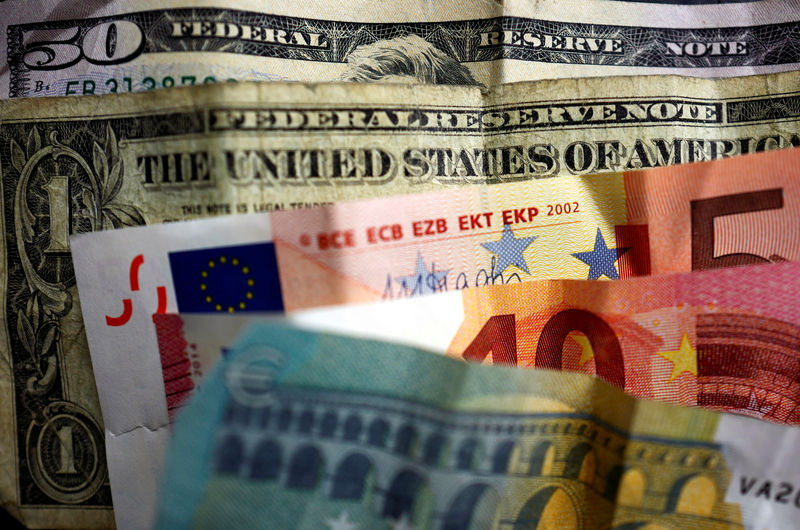Tonix Pharmaceuticals stock halted ahead of FDA approval news
Investing.com - The dollar has risen to levels against the euro not seen since November last year. Some analysts think still further gains are on the card, with the potential for the EUR/USD pair to fall to parity.
At 10:55 ET (14:55 GMT), the EUR/USD pair traded at 1.0690, recovering slightly from Tuesday’s trough of 1.0601, the lowest the pair has fallen to since Nov. 2.
The pair has fallen around 1% this week alone, and is approaching 4% lower year-to-date.
Factors Affecting EUR/USD Rate
The escalating geopolitical tensions between Israel and Iran have created a safe-haven boost to the U.S. currency, amid concerns that Iran’s first-ever direct attack on the state of Israel will result in a broad widening of the conflict between Israel and the militant group Hamas, impacting the price of oil in this crude-rich region.
“With the U.S. among the most energy independent major economies as well as the source of the world’s (high-yielding) reserve currency, it stands to reason that the USD should benefit from high risk premia linked to this conflict,” said analysts at UBS, in a note dated April 17.
However, the main factor driving the dollar higher, not only against the euro but also versus the currencies of most of the major industrialized countries, is the diverging performances of the relative economies.
“The driving story here is divergence, where strong U.S. jobs and particularly high inflation data (three months of core CPI at 0.4% month-on-month) means the Fed is in no hurry to cut rates,” said Chris Turner, Global Head of Markets and Regional Head of Research for UK & CEE at ING.
“From pricing six Fed rate cuts at the start of the year, the market is now pricing under two,” he added.
Fed Chair Jerome Powell said, on Tuesday, that recent data on inflation have not given policymakers the greater confidence needed for them to pivot to interest rate cuts soon.
This contrasted with his comments to a U.S. Senate panel, just over five weeks ago, that the Fed was "not far" from receiving that confidence.
By contrast, inflation is heading towards the European Central Bank’s medium-term target and last month the Bundesbank said that Germany, the region’s economic powerhouse, was likely in recession in the first quarter of 2024 as weak consumption and anemic industrial demand continued to weigh.
The ECB put an interest rate cut in June on the table on Thursday, arguing that price growth was decelerating towards 2% and the 20-nation bloc was "not the same" as the U.S., which is struggling with unexpectedly stubborn inflation.
“The ECB is keen to show its policy independence saying that eurozone inflation had been supply-side led (and abating) while the U.S. is suffering some stickier demand-led inflation,” Turner said. “The market prices just over three ECB cuts this year.”
EUR/USD Price Forecast 2024
This divergence between the Fed and the ECB narratives is likely to lead to further EUR/USD losses, with ING looking for the pair shortly to test the 1.0600 psychological level.
It seems unlikely that this will be a strong technical support, the bank added, and instead, the next big support levels may be at 1.0500 and the 1.0450 October low.
“Crucially, the lack of market moving data releases and the dollar drawing benefits from other FX developments means a move to the 1.05 area in the near term is a rather tangible risk,” said Francesco Pesole, an analyst at ING.
UBS cut its EUR/USD in a note dated April 17, now forecasting the pair to trade at 1.0500, from 1.1200, at the end of 2024, and at 1.0500, from 1.0900, at the end of the second quarter.
“We suspect that as the ECB starts to cut rates while the Fed lags, the EUR will come under further pressure,” said analysts at the Swiss bank. “That this thesis is widely subscribed to can slow the move but probably can’t reverse it.”
ING keeps to a year-end forecast of 1.1000, but “the risks are skewed to a lower EUR/USD – be it through an escalation in the Middle East or a Trump presidency which would be negative for the world and bad for the pro-cyclical euro.”
Will EUR/USD Hit Parity?
A fall in the pair to parity is not a widely held central case, with ING’s Turner noting that although the divergence in policy rate spreads is at its widest since late 2022 when EUR/USD went below parity, the structural scenario is not as negative.
“Low gas prices mean that the eurozone’s terms of trade are in a much better position – and suggests that if yield differentials do drive EUR/USD sub 1.05 – it should not stay there for long,” he added.
That said, higher energy prices pose a new terms-of-trade risk for the euro, UBS noted, and there is also the chance that the U.S. introduces further tariffs if the Republicans win the presidency.
That would be a “clear negative that leaves room for a test of parity on a medium-term horizon - wider ranges should be expected as the year progresses,” the Swiss bank added.
Forex Trading: Find Opportunity in Currency Fluctuations
Forex is the largest and most liquid financial market in the world, with trillions of dollars traded daily.
The foreign exchange (forex) market is a global decentralized market for the trading of currencies. While there are large risks for investors who trade forex, there are also high potential gains. Learn more about how forex trading works through our Academy article.
